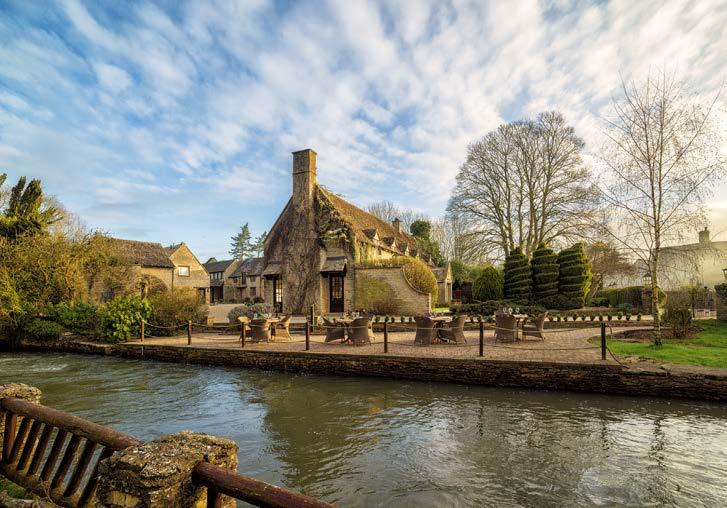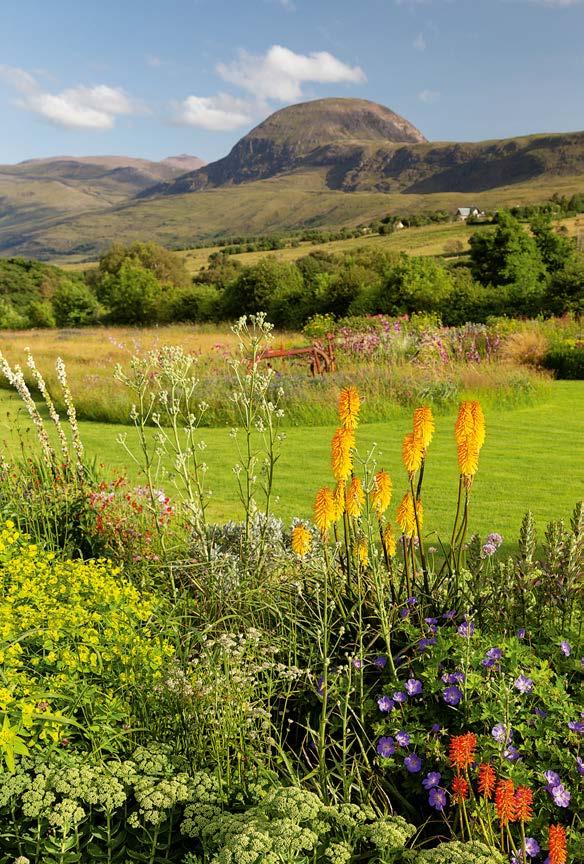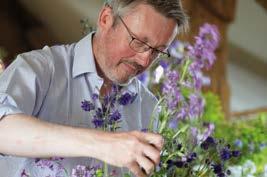
17 minute read
Craftspeople David and Julia Bridger
Keyneston Mill Estate, in the idyllic countryside of the Tarrant Valley near Blandford Forum in Dorset, is home to Parterre Fragrances, founded by David and Julia Bridger in 2015. “We were already growing cut flowers and herbs when we went on a trip to the south of France,” Julia recalls. “We visited Grasse, the heart of the French perfume industry, and that inspired us to grow scented plants to create our own perfume.”
On their return they set about finding a location for their venture. Six years on, a 50-acre estate has been transformed from fields of grass and nettles

Above Harvesting a large basket of Achillea ‘Cerise Queen’ to distil its hayscented essential oil. Above right Julia and David Bridger, founders of Parterre Fragrances. into a flourishing, aromatic hub, with formal gardens that double as trial beds; fields where crops such as vetiver, hyssop and scented geraniums are grown; and buildings that are home to a bistro and gift shop, plus venues for perfume-making workshops. David and Julia have gathered together some of the best in the business, including horticulturists who trained or worked at Kew, the RHS and the National Trust. They also work with Master Perfumer Jacques Chabert, who is based in Grasse and blends the essential oils they grow and distil to formulate Parterre’s bottled fragrances. The formal gardens at Parterre are known as the Collection Gardens. They are divided into four di erent areas, each focusing on a di erent perfume family – citrus, spice, floral and fougère, from the French word for fern. The floral section takes its inspiration from the Orto Botanico di Padova, the world’s oldest botanic garden, founded in the Italian city of Padua in 1545, and is a heady mix of roses, sweet peas, jasmine and lilies. These gardens are also where the Bridgers try out unusual plants, distilling them in small batches to see if they’re worth producing on a larger scale in the crop fields. “We grow about 1,500 di erent plants in the Collection Gardens,” explains Julia. “Some are grown in small quantities and we might not use them in the perfumes, but they’re there because they help us tell the story of the world of perfume for visitors.” The visiting public are actively encouraged to rub leaves and sni flowers and to enjoy the immersive experience of being surrounded by these scented plants here at Parterre.
“We grow our plants from seed and cuttings, planting them out in spring in rows in the fields or in



square beds, then we nurture them over the coming months,” Julia continues. “In the crop fields we’ve got about 40-45 di erent plants and, depending on whether they’re annuals, biennials or perennials, it might be anything from a couple of months to a year or so before we can harvest them. Some crops are harvested and taken straight to the distillery; others, like vetiver, are dried first before being distilled. Most plants are best picked in the morning once the dew has evaporated and we mostly harvest by hand. We then take our harvest to the long barn, which is home to our stills and is where we do most of our distilling by steam, since that’s the best way to extract the oil from plants. The smallest still is called Daisy and is used for more compact plant material, like the small leaves of thyme, whereas Dorothy, the largest still, is used for the more lush growth of plants like mint and pelargoniums.”
While leaves and flowers are the focus of summer distilling, the team also distil in autumn and winter. It’s at this time of year that they turn their attention to roots such as vetiver and seeds like those of wild carrot, which have a spicy aroma.
“After distilling we let the oils mature for a while before sending them to Jacques in Grasse,” says Julia. “He blends the oils and sends us samples so
Above left Freshly picked achillea flowers are taken to the long barn for distilling by steam. Above centre Some crops are dried before being distilled. Above right The distilled essential oils are sent to Jacques Chabert in Grasse to be blended into unique perfumes. Below The beautiful Collection Gardens are divided into four perfume-themed areas.




we can select our favourites, which he then develops into the perfumes. There can be up to 50 di erent essential oils in a fragrance and the key is to get the mix of scent molecules working together, so it smells good when you first spray it, but lasts on the skin and still smells good at the end of the day – something that’s very hard to achieve. It takes seven to eight years of training to become a perfumer, and you can’t be called a ‘Master Perfumer’ until you’ve created a world-renowned perfume.” The final product comes back to Dorset where it’s bottled and numbered. Parterre produces a set volume of oils every year, so each perfume is a limited edition.
Top The Collection Gardens feature all kinds of perfumed plants, plus plants being trialled for larger-scale growing. Above left Each bottle of Parterre’s small-batch perfume is numbered. Above right A tiny bottle of essential oil from Achillea ‘Cerise Queen’.
Tribute to Edith is one of Parterre’s four current fragrances (there are another two in production) and is inspired by 1920s and ’30s Paris, when rose was a popular fragrance. It’s also a nod to French chanteuse Edith Piaf and her song La Vie en Rose. “It’s di erent from other rose perfumes because we use oil distilled from rose-scented Pelargonium ‘Graveolens’, and a cultivar of yarrow, Achillea millefolium ‘Cerise Queen’. Yarrow isn’t normally used in perfumes, but we tried it and not only does it look fabulous in the field because of its gorgeous mix of pinks, but it also produces an oil with a warm, hay-like scent, which means the final product doesn’t have the sweetness of other rose perfumes.”
Pushing boundaries is part of Parterre’s ethos. Vetiver, for instance, is a grass native to India that is grown commercially for the perfume industry in Haiti and Java. “It’s used in a lot of fragrances as a base ingredient because it’s very stable and works well with other aromas, so we thought we’d give it a go – and it rather seems to like Dorset!” notes Julia.
David and Julia chose the name Parterre because its literal translation from French means ‘of the earth’. It seems a fitting choice for a business that captures the scents of Dorset from home-grown seed, turning them into unique bottled fragrances.
Visit keynestonmill.com to plan a visit to Parterre’s gardens. To learn more about their range of fragrances or to buy from the online shop, visit parterrefragrances.com
Prize can be taken any time before June 2022 WIN A
GREAT BRITISH
HOLIDAY

Your once-in-a-lifetime trip includes:
● Free international fl ights (if applicable) ● One-night London stay ● Two-night stay in Edinburgh ● Visit to Edinburgh Castle ● Tickets to Blenheim Palace ● A night in a Cotswolds hotel ● West End tickets with dinner

Enter our competition for your chance to win a holiday in Britain for two worth up to £5,000, including free international fl ights
What would your dream holiday to Britain include? A fi ve-star stay in London and tickets to a West End show? A trip to historic Edinburgh? How about a stay in the Cotswolds, including a visit to one of Britain’s fi nest stately homes? Well, with our Great British Holiday competition, you can win all of this and more.
London luxury
Starting with free fl ights (for overseas entrants), the winner and their guest will travel to London for a luxury one-night stay at the Athenaeum, a fi ve-star hotel in the heart of Mayfair – just a short stroll from Buckingham Palace, Piccadilly Circus and the Royal Parks.
Your visit will also include tickets to a top West End show of your choice, with a lavish three-course meal with wine at Prezzo to make your night one to remember.
Historic Edinburgh
Next, our winner and their guest will head to Edinburgh for a stay at the luxury Radisson Collection Edinburgh, located on the famous Royal Mile, with stunning views of the Old Town. During your stay you’ll visit the iconic Edinburgh Castle, followed by a special three-course dinner.
The charming Cotswolds
To conclude your trip, it’s time to escape to the countryside to visit one of Britain’s fi nest stately homes and the birthplace of Winston Churchill: Blenheim Palace.
Accommodation for the night will be at Minster Mill, a glamorous and luxurious hotel on the banks of the River Windrush in the historic village of Minster Lovell.
After a full English breakfast, you can take advantage of the hotel’s top-class facilities – from its spa to its croquet lawn – or explore the idyllic Oxfordshire Cotswolds, home to some of England’s most beautiful villages.



HOW TO ENTER
Go to www.theenglishgarden.
co.uk/GBH2021 or fi ll in the coupon on the right with the answer to the question:



Question: Which famous Brit was born at Blenheim Palace? a) Isaac Newton b) Queen Victoria c) Winston Churchill

IMAGES SHUTTERSTOCK
TERMS AND CONDITIONS
Closing date for entries is 31 July 2021. The winner will be announced on www.theenglishgarden.co.uk on 7 August 2021, and the holiday can be taken between 1 September 2021 and 31 May 2022, subject to availability. For full terms and conditions, go to www.chelseamagazines.com/GBH2021 Two annual tickets to Blenheim Palace, one of the country's fi nest stately homes and the birthplace of Winston Churchill. www.blenheimpalace.com

One-night stay for two at The Athenaeum, a fi vestar hotel in London's Mayfair district, near Buckingham Palace. www.athenaeum hotel.com
One-night stay for two at Minster Mill, a luxurious Cotswolds hotel near Blenheim Palace. Includes breakfast. www.minstermill.co.uk Two-night stay for two including breakfast at the Radisson Collection Edinburgh on the city's Royal Mile. www.radissonhotels.com
Two premium theatre tickets, plus a threecourse meal at Prezzo for two with wine, from Buyagift, the UK’s leading provider of experience days. www.buyagift.co.uk
Visit Edinburgh Castle, the Scottish capital's unmissable historic attraction, followed by a three-course dinner for two from go-to gift experience company Red Letter Days. www. redletterdays.co.uk
SEND YOUR COUPON TO: US readers: Great British Holiday Competition 2021, The English Garden, C/O NPS Media Group, 2 Corporate Drive, Suite 945, Shelton, CT 06484 UK and ROW: Great British Holiday Competition 2021, The English Garden, Jubilee House, 2 Jubilee Place, London, SW3 3TQ, UK
My answer:
Name:
Address:
Postcode:
Tel no:
Email:
Terms and conditions apply. For full details go to chelseamagazines.com/ terms-and-conditions Please tick here if you subscribe to The English Garden Please tick if you are happy to receive relevant information about new products or services from our competition partners via email , post , or phone , and/or The Chelsea Magazine Company via email , post , or phone
The Reviewer
A selection of the best writing on the shelves this month

The Kew Gardener’s Guide To Growing Roses
by Tony Hall Frances Lincoln, £12.99
Like Astaire and Rogers, Simon and Garfunkel, and French and Saunders, roses and English gardens are a dream partnership and it is di cult to imagine one without the other. Yet even to the well initiated in these matters, it can at times be almost impossible to decide on the perfect rose to grow.
To assist, author Tony Hall has selected 78 good candidates, grouping them by wide-ranging functions or locations and noting their idiosyncrasies. There are roses for hips, shady spots, training as standards or growing in containers. He makes the case for ramblers and climbers and picks good roses for training against walls – ‘Reine des Violettes’, ‘Roseraie de l’Hay’, ‘Rosy Cushion’ and Rosa roxburghii, although many will doubtless have an opinion on that.
Threaded through it all is the sort of sound advice to be expected from this established writer (his Gardening with Drought-Resistant Plants was published in 2020). He also o ers definitive explanations as to the di erences between roses types, clearing up any debate over floribundas, grandifloras, climbers and ramblers.
Can a garden have too many roses? Many would argue not. And although the bare-root season has passed, it’s not too late to put in a rose for later flowering. If that is on your mind, this book will help you choose just one more – and outline how and where to grow it.
Herb/A Cook’s Companion
by Mark Diacono Quadrille, £26
To the canon of works on herbs, Marc Diacono adds a fresh, contemporary take on the subject. His writing is engaging and draws deeply from personal experience of both growing and cooking these valuable plants.
While you’ll find the usual suspects such as parsley, rosemary and so forth, Marc has slipped in a few wildcards that will make you think again. Fig leaves, for instance, make a wonderful flavouring for ice cream and, when toasted, can bring a sweet, slightly nutty flavour to rice. Some additions are less practical – it’s di cult to imagine having many avocado leaves to use – but these are the exception, rather than the rule. There is plenty of growing advice and recipes are diverse and inspiring, among them, picada from Catalonia, adjika from Georgia and hearty French pistou. This wonderful book will enhance the shelves of gardeners and cooks alike. Plant. House Plants: Choosing, Styling, Caring
by Gynelle Leon Mitchell Beazley, £15
The quality of our interior spaces can have an immense e ect on the way we experience and view the world. Houseplants have rightly enjoyed their place in the sun in recent years, being popular with millennials in smaller homes of course, but also among those who have had to remain indoors for the past year.
Houseplants are all too easy to kill and many is the plant that found itself in the wrong place at the wrong time. Gynelle Leon is the founder of Prick, the Hackney shop specialising in cacti and succulents. Her first book, also called Prick, dealt with that topic. In Plant, she shares knowledge on choosing, styling and caring for leafy houseplants. There are 100 plants noted here and what stands out is their diversity. From broad-leaved Ficus elastica, to filigree Tillandsia usneoides, a world of greenery awaits the attentive grower.
Next issue
ON SALE 6 JULY
A crescendo of colour
• A naturalistic, organic garden at Somerset’s Cooks Farm • Dreamy herbaceous borders in the garden at Craichlaw in Scotland • Spectacular topiary at Hampshire’s historic Weirs Barn • A collection of southern hemisphere beauties at Durnamuck in the Highlands • The quirky garden at Dy ryn Fernant in Wales
PLUS Four families who restored historic gardens; a guide to growing dahlias for cutting; expert advice on monarda; and Shropshire Petals’ home-grown confetti




Don’t miss out. Subscribe now at britsubs.com/englishgarden 800-998-0807
The Life Aquatic
Repairs to Morville’s formal pond turned out to be more far-reaching than expected, but Katherine Swift eagerly anticipates its recolonisation
Angels come in many guises. Mick was crop-headed, craggy-faced, and arrived towing a rusty tanker behind his out-sized tractor.
The problem with over-mature gardens is not simply that trees and shrubs need drastic pruning, nor that hedges need cutting back or even completely replacing, but that major pieces of infrastructure may need renewing too. Which is where Mick and his ‘gully sucker’ came in.
Recently the pump had to be replaced in the canal – a 2,000-gallon, stone-lined formal pond, originally constructed in 1997. No problem there. But in doing that, the outlet hose broke under a metre and a half of water. And that meant draining the entire canal in order to mend the hose.
The canal and the round pond that feeds it comprise a metre-and-a-half-deep ecosystem of pond life: water beetles, water boatmen, pond skaters, water snails; a visiting grass snake or two; in spring a fringe of honeybees collecting water to dilute their stored honey; somewhere for the blackbirds to wash their dusty feathers. And, above and below the water, a place where dragonfl ies live out their complicated lives – the hawkers, darters and chasers, hunting, mating, and patrolling the canal in search of prey, and the damselfl ies, smaller and more delicately framed, distinguished by the fact that they close their wings at rest – unlike dragonfl ies, which perch with their wings spread.
Damselfl ies and some dragonfl ies lay their eggs on surrounding plants; others lay them directly in the water. But after hatching, they all need water in which to develop. Their fearsome larvae, also known as nymphs, have segmented legs, compound eyes and strong jaws, and live in the bottom sediments, where they feed by ambushing other, smaller creatures.
We keep the water free of algae by means of a UV unit and fi lter, but I had not cleaned out the canal for 20 years for fear of disrupting its precious ecosystem. Having been forced to drain the canal by the recent series of misfortunes, I thought we should take the opportunity to clear out the sludge and repair the decaying stonework.
The canal is at a higher level than most of the garden so most of the water exited fairly painlessly by siphoning, and the rest was pumped out using the motor of an antiquated pond vac lashed to a garden hose with duct tape. But then we were left with a 10cm layer of sludge the colour and consistency of dense pea soup. I had imagined that the sludge would either be thick enough for us to shovel or thin enough for the pond vac to handle, but neither turned out to be the case. And nothing and no one seemed able to help: I couldn’t fi nd a suitable pump for hire, and the owners of tankers for emptying septic tanks politely declined. I almost despaired. That was where Mick came in. An hour and a half, and job done. Now, on warm days from May onwards, the dragonfl ies and damselfl ies will be starting to emerge from their larval state before fl ying o in search of a mate. Within a hundred metres or so of the garden lie three natural ponds, relics of the medieval fi shponds of Morville Priory. I am hoping that the wildlife endemic there will recolonise the canal but, just in case, we have saved a couple of barrels of sludge with which to inoculate the new water. I feel like putting up a sign: ‘Vacancies. Dragonfl ies this way!’

Havingacritiquefrom someonewhoisclearly anexpertgivesyou confidence-theyreally knowwhattheyare talkingabout.
-David

Givethejoyof learningthis Mother'sDay
HelpMomrediscovertheloveoflearning underthewatchfuleyeofsomeoftheworld's biggestnames. Meetenthusiastsfromaroundtheworldand tryproject-basedlearning, getpersonalised feedbackfromtheexperts,allinourinteractive onlineclassroom. Whetheryou'rebuyingforagardening enthusiast,thefoodieofthefamily,ora buddingphotographer-we'vegotonline coursesforeveryone.

Roses taughtbyMichaelMarriott



PietOudolf &NoelKingsbury
PlantingthePiet OudolfWay
LearnPietOudolf's gardendesignsecrets directlyfromPietand long-timecollaborator DrNoelKingsbury.






DrTobyMusgrave
HeritageFruit &Veg
Findouthowtogrowthe verybestold-fashioned varietiesfromHeritage orHeirloomseedsand cultivarswithDrToby Musgrave.
Itisamazingtobeabletolearnand receivefeedbackdirectlyfromtheexperts.








